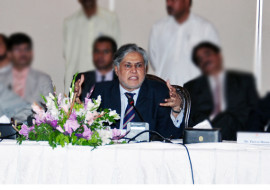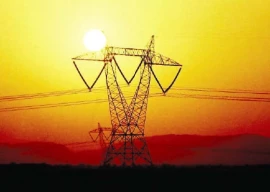
ISLAMABAD:
In a desperate attempt to soothe an unnerved foreign currency market, which is causing faster than anticipated rupee devaluation, Pakistan has borrowed $625 million from two consortiums of international and domestic banks.
The federal government has entered into an agreement with a consortium of Bank of Tokyo, Bank Al Falah and Swiss Bank for $425 million oil financing facility for one year, according to Finance Ministry sources.
This facility has been obtained to meet the increasing demand of US dollars for opening letters of credit for import of oil, they added. The move is aimed at interbank stability, as increasing demand for the dollar was causing rupee devaluation in the interbank market where the speculative element is considered to be minimal.
To streamline the demand for dollars for oil imports, the Economic Coordination Committee of the Cabinet has recently discussed the option of limiting oil reserves levels.

The country will pay an interest rate of 5.3% over and above the London Interbank Offered Rate (Libor) on fresh borrowing. The mismanagement of foreign currency reserves by the present management of the State Bank of Pakistan (SBP) is now forcing the PML-N government to take expensive short-term loans.
Finance Minister Ishaq Dar has recently counted increasing demand of dollar for oil imports and speculations as key reasons behind massive rupee slide against the greenback.
When contacted, spokesman for the Finance Ministry Rana Assad Amin confirmed that the government obtained fresh credit lines from consortium of banks. He said the government was doing its best to cushion the markets.
In the open market, the dollar was traded at Rs107.80 as the State Bank of Pakistan failed to take any action against foreign exchange companies that were involved in speculative trading. The government had hoped that the $6.7 billion IMF package would help comfort the foreign exchange markets.
However, the benefits that the federal government was immediately expecting were being eroded due to inaction by the central bank, according to former SBP officials.
The government also borrowed another $225 million from a consortium of Standard Chartered Bank, United Bank Limited, National Bank of Pakistan and Allied Bank Limited, the sources said. This credit line has been obtained to shore up foreign currency reserves, held by the SBP.
Till September 13, the reserves held by the central bank stood at $5.118 billion. In addition to that the reserves with the commercial banks were recorded at $5.256 billion. The total reserves amounted to $10.378 billion which after materialisation of these credit lines are expected to rise to $11 billion.
Under the arrangement, both consortiums are bound to arrange money from outside Pakistan so that the purpose of getting these short term expensive loans was fulfilled, the sources added. The money will come to Pakistan within next two weeks.
The fresh borrowing will also help Pakistan to achieve net foreign asset targets, given by the IMF for the first quarter and for the whole fiscal years.
As against net minus $2.437 billion by end June this year, Pakistan is required to jack up the reserves to positive $2.532 billion. The net reserves are calculated by substracting $871 million borrowed from China under currency swap arrangement, $2.4 billion borrowed from commercial banks under forward contracts and Pakistan’s obligations towards IMF from total reserves.
Published in The Express Tribune, September 24th, 2013.
Like Business on Facebook, follow @TribuneBiz on Twitter to stay informed and join in the conversation.
COMMENTS (8)
Comments are moderated and generally will be posted if they are on-topic and not abusive.
For more information, please see our Comments FAQ



































































The reason for devaluation of the currency is due to the rapidly rising current account deficit. In turn, the current account deficit rises due to imports that don't generate economic growth. Some examples are import of military equipment, cars and other consumption oriented items. Oil imports, while partly may be generating economic activity, but it is mostly used for consumption such as gasoline and home energy.
It is best to let the currency fall and find a natural equilibrium. This will have the result of reduced imports of military and consumer items. The freed-up foreign exchange can then be put to work in economic activities that adds true growth to the economy helping produce more exportable value added items. Artificial manipulations to keep the exchange rate stable will only work on a very short term basis.
etblog2013
@sgrr: No need to boroow if they put their own house in order!
LIBOR+5.3%, it means approximately 6%, I think a number of NRPs ready to lend US$ to GoP at this rate if approached properly.
What do you call an Special Purpose Vehicle (SPV) or an Special Investment Vehicle (SIV) or an off-balance sheet Enron style accounting in Pakistan? Thats right! PSEs..
Sorry I meant FY12 not FY13.
Apart from incompetent handling by SBP management resulting continued slide in rupee parity rate, the non development lavish expenditures like importing 200 expensive bullet proof vehicles for elites, abnormal decline of interest rates on rupee savings added to it recent extending of liberal heavy fiscal concessions to businessmen are some of the reasons making Pak rupee less attractive and consequent unchecked free fall in its parity rate against US Dollar. The decline in its value has a devastating effect on masses of Pakistan besides of galloping inflation, of making Pakistanis poorer and poorer with every fall for the fault of holding their rupee denominated assets and to lose heavily with corresponding effect on elite classes of making them richer and richer and heavy gainers overnight at the killing cost on masses.
This slide is being done during the tenures of said to be democratic governments of for the people and by the people as against during the tenure of Military rule of General Parvaiz Musharaf when country saw rupee strengthening from the level of Rs.86 per $ when he took over to stabilise at Rs.58 per$ and remained stable throughout his period around Rs.60 per $ despite footing all import bills including of oils etc., hence giving reason for recent decline of payment on heavy bills for import of oils is no excuse.
@gp65: The IMF has said in their report that the SBP spent $3.5 billion or more than 70% of reserve loss in FY13 defending the rupee! It also reduced interest rates with the last rate reduction just a few months ago. So, yeah, severe mismanagement.
http://tribune.com.pk/story/604371/election-campaign-previous-govt-spent-3-5b-to-stem-rupee-slide-before-polls/